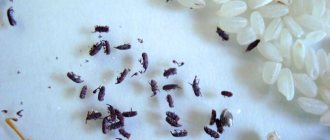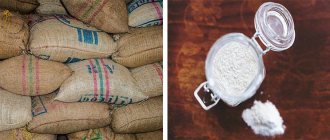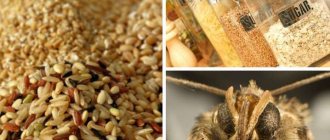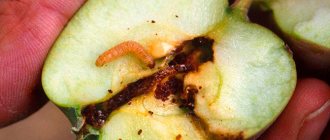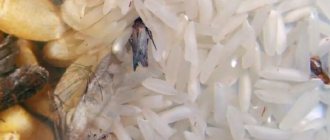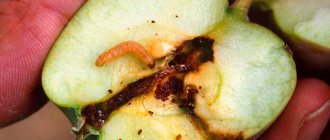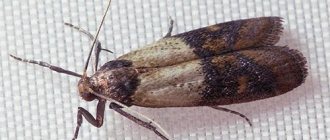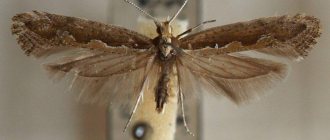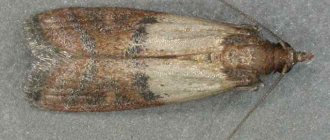A small butterfly flying through your kitchen is a serious enough reason to start worrying about the safety of your food. Most often, parasites feed on cereals and grains; moths are also often found in dried fruits. These insects feed while at the caterpillar stage, making small holes in dried fruits and entangling themselves in a silk cocoon.
What does food moth look like?
This pest belongs to the order of Lepidoptera butterflies. The body length does not exceed 1 cm. The main color is gray, but black horizontal stripes are clearly visible on it, which distinguishes this species from others.
The front wings of the food moth are narrow-lanceolate and pointed. The hind ones are wider with a characteristic fringe along the edge. The fruit moth has large eyes and also has sensitive antennae that help it accurately find foods where it can lay eggs.
The peculiarity of this inconspicuous butterfly is that it does not have a proboscis. This is due to the fact that during the transformation into a sexually mature individual, the insect loses not only the ability to eat, but also to digest food, so there is no need for this organ.
The eggs of the pest are oval. Their size is approximately 0.5 mm. The shade of their shell changes. It is initially milky white and later turns yellow-orange. During oviposition, females secrete a sticky secretion, which allows the eggs to be securely attached to the surface of food.
Larvae and adults of the pest
The caterpillar larvae of food moths are light in color, only the head is darker. They move well and are characterized by increased gluttony, as they have a well-developed gnawing-type mouthparts. For this pest, cellophane and cling film are not an obstacle. As they grow older, their color changes and becomes milky white. The body of the caterpillars is shortened.
The pupa of the food moth reaches 6-6.5 mm in length. Initially it has a straw-yellow hue, and later becomes dark brown. The development of the food moth pupa occurs in dried fruits. This process takes from 7 to 15 days. Then a new sexually mature individual appears, which is ready to breed within a day.
It is quite difficult to detect the appearance of moths in dried fruits at the initial stage of infection. The insect is nocturnal and prefers to hide from daylight.
Features of the insect
Getting rid of fruit moths is difficult - this voracious insect is not so easy to detect at the very beginning. The fact is that adults are already flying around the kitchen, but they don’t eat anything at all. Their main goal is to find a secluded place and lay eggs there, from which moth larvae will hatch in a few days. It is they who turn delicious dried fruits into real dust.
You can recognize fruit moths by the characteristic stripes on the tips of their wings. It is small in size, only about 1 cm long. Look at what the fruit moth looks like in the photo, so that if it appears, you can identify the enemy by the appearance of the moth butterfly. The grown larvae can be seen with the naked eye; they do not look like small worms. They hatch from eggs hidden in a cocoon, as if made from a cobweb.
food moth
Fruit moths can appear not only in dried fruits. An excellent habitat for it are bags of cereals or flour. Moth larvae prefer to eat sweet fruits, but the butterfly can lay eggs in a dry place next to them, and the hatched larvae will crawl to the delicacy on their own.
Fortunately, they do not crawl long distances, so fruit moths can appear in an apartment only in one of the following ways:
- fly through the ventilation ducts and settle in the food cupboard;
- entering the house with a new batch of low-quality dried fruits;
- fly into an open window, especially in the evenings when the lights are on in the windows.
Where does it come from?
Food moths can get into a person’s home in different ways. Pest larvae may already be in products purchased in stores, since storage conditions in warehouses do not always correspond to the norm. And this leads to the proliferation of the pest. In the absence of dried fruits, moths appear in cereals, flour, tea and nuts. The only things that don't appeal to her are spices and coffee.
Pupae of the pest may also initially be found in fruits that have been used for drying. And since they are subsequently stored in a dry, dark place, such conditions are ideal for further reproduction.
Moths can also fly in through an open window at night. As a result, she finds a favorable place and lays eggs.
Working folk methods: which ones to choose?
Those who consider chemicals too dangerous and the disposal and destruction of insects by lowering or raising temperatures are not so effective should try to solve the problem with the help of folk remedies. Recipes for some of them are below:
Read also: How and with what to wear leather items
- Table vinegar. All surfaces infected with the bug are treated with a vinegar-based water solution, along with the simultaneous disposal of cereals and flour damaged by pests.
- Bay leaf, pepper, garlic, sulfur. All of these are products whose smell is feared not only by flour bugs (the photo below will prevent you from making mistakes in identifying pests), but by other types of insects.
- Antiseptics of natural origin - chamomile or calendula can also repel pests.
An interesting option that allows you to forget, if not forever, then for a long time, what bugs in cereals are (a photo will help you correctly identify the type of each) is a trap based on boric acid.
Bait works on a simple principle: insects are attracted to the bait. Hungry bugs try a poisoned treat, become infected with toxins and poison the rest of the colony.
To prepare the bait, boric acid is mixed in a container with powdered sugar, semolina, honey, and syrup. Treats will only attract pests if they are fresh. It is recommended to use traps when children and pets are not at home, placing them in insect habitats.
The problem of the appearance of beetles in cereals is relevant. This is due to an unscrupulous attitude towards the saving conditions of producers, since most insects end up in cereals when packaged in factories.
Dried fruit protection
You can prevent the appearance of fruit moths if you take care in advance about the proper storage of food. To do this, it is necessary to prevent a sexually mature individual from laying eggs.
How to save dried fruits from moths?
Favorable conditions for moth reproduction are temperature +250C degrees and humidity within 50%. Infection can be eliminated if you prepare food for storage, select containers and determine the location.
Storing dried fruits
Preparation for storage
To prevent moths from infesting dried fruits, you must first check their quality. To do this, you need to sort through them and remove everything that causes suspicion. Then, as a preventive measure against mold and insects, you should additionally dry them in the oven at a temperature of +60-800C for half an hour.
Attention! The shelf life of dried fruits is 12 months. After this period they should be disposed of.
Selection of containers
To store dried fruits, you must use hermetically sealed glass containers. After pouring the product into them, you need to put a paper napkin on top, which will absorb moisture.
Determining the storage location
Dried fruits must be stored in a dark, dry place where sunlight does not penetrate. The best option may be a shelf in a pantry or closet.
Protective measures
To preserve dried fruits and protect them from moths, it is necessary to check them regularly throughout the storage period. If stickiness appears, dry it in the oven. Also, to prevent high humidity in the storage area, you should place containers with salt nearby, which will absorb excess moisture.
How to store dried fruits
Dried fruits should be stored properly. Only if special conditions are met can you count on the fact that the quality of the product will not suffer, and it will retain all the useful vitamins and microelements, and will not harbor moths:
Air temperature and humidity
The optimal temperature for storing dried fruits is no higher than +100C. It is important that the air humidity is within 65-75%. If storage conditions are inappropriate, chemical processes are accelerated, which leads to premature spoilage, and this is also a provoking factor for the appearance of a pest.
How to save?!
Is it possible to eat grains and flour infested with beetles?
Food should not be consumed together with insects. Before using cereals, you need to get rid of pests.
However, even careful processing will not be able to remove larvae, scales, and waste products of beetles. They pose no danger to a healthy adult.
Before using cereals you need to get rid of pests
It’s a different matter when it comes to children and people with weakened immune systems. In these cases, the use of such products can cause a severe allergic reaction or cause intoxication of the human body, which will lead to disruption of the functioning of the gastrointestinal tract and an increase in body temperature.
What to do if dried fruits are contaminated?
If there are moths in dried apples, you need to take urgent measures to save the remaining stocks. Otherwise, these insects can completely spoil all products. The situation can be corrected only if the damage is minor, otherwise the dried fruits should be thrown away.
Heat treatment
If adult flying individuals were found in the house, but their worms are not visible in the product, then heat treatment can be carried out for drying. To do this, you need to pour it onto a baking sheet and heat it in the oven at +60...700C for 40 minutes.
This pest does not tolerate low temperatures. Therefore, to save drying, you can place it in the freezer and leave it for a day.
Using improvised means
The means at hand will also help to cope with the problem. If there are moths in dried fruits, you need to dispose of spoiled products, and prepare special traps for adult moths. To do this, you will need to mix boric acid with flour in a ratio of 1: 3. Place the resulting mixture in separate containers and place them on the shelves of a cabinet or pantry.
Folk methods of struggle
In the fight against pests, you can also use folk remedies, especially since it is not always advisable to use chemicals in the kitchen next to food.
Effective ways to get rid of moths:
- Lavender. Place bunches of this herb on shelves where dried fruits are stored.
- Citrus. To repel the pest, chop the fruit peel and place it next to the drying container. It needs to be updated periodically.
- Vinegar. Dilute it with water at the rate of 1:3. Wipe the inside of the cabinets where the product is stored with the resulting composition.
Lavender
Destruction of moths
Methods for killing moths
The moth is not distinguished by its quick reaction or strong flight abilities. It's easy to slam him. But there is no guarantee that this is the only or last butterfly in the room, so you should play it safe and use effective moth repellents in the apartment and in the kitchen in particular.
- Sticky tapes are hung around the kitchen, anti-moth tablets and special traps are used in cabinets.
- Among the folk remedies, herbs such as lavender, peppermint, chamomile, and geranium will help repel the pest. These plants repel moths with their scent. Orange peels and garlic are also excellent repellents.
- Ventilating the kitchen for 20 minutes every evening during cold periods reduces the activity of moths and creates unfavorable living conditions for them.
- In case of severe infestation of the premises, aerosols and moth sprays are used. Initially, they carry out cleaning to destroy the larvae, wipe down the cabinets, and hide the food in airtight containers. Disinsection is carried out. Use any insecticidal agent - Raptor, Raid, Antimol, Clean House, Dichlorvos. After 20 minutes, ventilate, carry out wet cleaning by adding baking soda and laundry soap to the water. An alkaline environment completely neutralizes the effect of the insecticide.
Not only does dry fruit attract moths into the house, any food supplies can become contaminated if the insect gains access to them. Preventative measures are extremely important to prevent infection.
Prevention
By following simple prevention rules, you can reduce the likelihood of fruit moths to a minimum.
Basic Rules:
- maintain optimal mode;
- store different types of drying in separate containers;
- periodically ventilate cabinets;
- once a month, sort through the supplies and, if necessary, dry them in the oven;
- lay out special traps, cassettes, tablets against the pest and its larvae on the shelves;
- carefully inspect products when purchasing in a store.
Frozen storage
With the advent of spacious freezers in our lives, it has become common to keep crops frozen
When frozen, dried fruits lose some of their nutrients, but if there is no other option other than freezing, it is important to know how to store dried fruits in the freezer
No special preparation is required when storing. Dried fruits are placed in small batches in storage containers (food containers or zip-lock bags) and frozen.
Dried fruits can be stored in this way for several years, provided that they are not defrosted and the temperature in the freezer is at -20°C or lower.
Defrosting should only take place at room temperature. It is best to first place the products from the freezer on the top shelf of the refrigerator, and after a few hours at room temperature. You should not defrost the preparations in hot water or the microwave; the fruits will become tasteless and too soft.

